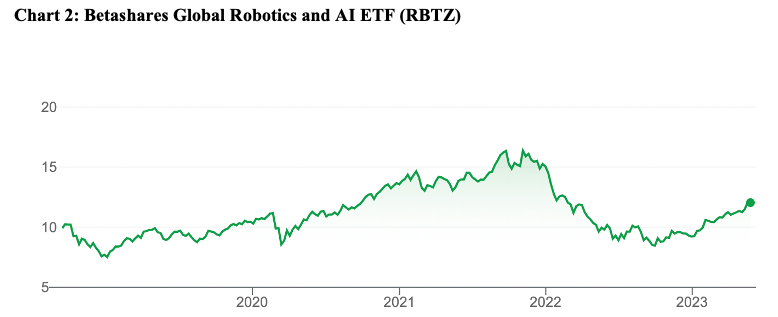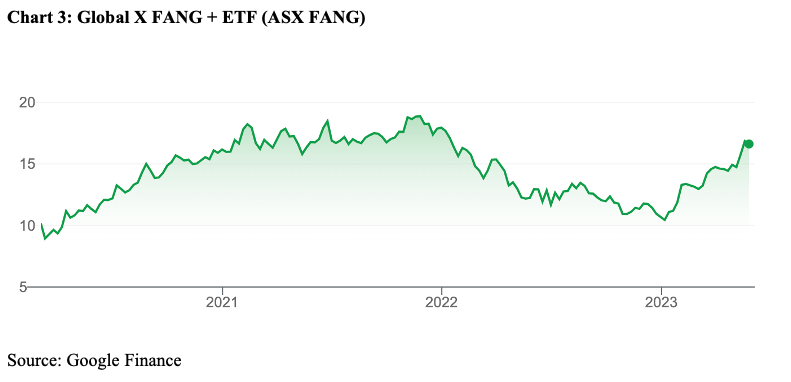I mostly avoid writing positive stories about stocks and sectors after they have big rallies. Often, the hype exceeds reality and the valuation is stretched.
Yes, there are times to buy stocks that have rallied. For years, I have favoured buying the big advertising portal stocks – REA Group, Carsales.com and Seek – even though they always look expensive. The key is to buy on any short-term pullback.
Blinkered views on valuations metrics are dangerous. For years, REA Group looked to have a nose-bleeding valuation based on its Price/Earnings (PE) multiple. But REA’s high multiple (to a point) was justified by its growth prospects.
Every stock and sector is different. Each should be treated on the merits, according to valuation. Avoiding an investment because it has rallied is dumb.
This brings me to Artificial Intelligence (AI) stocks, a much-hyped part of the market this year after interest in ChatGPT. In the past few months, several big tech stocks have got a boost from investor interest in the AI craze.
That’s encouraged some investment banks to dust off their best AI stock recommendations. Commentators have opined about the merits of AI. Will it unleash the next great wave of productivity gains? Or destroy civilisation, as some argue?
These are crazy extremes. For what it’s worth, I agree that authorities should look to slow AI’s development, so that regulation and ethics can catch up. Social media got out of hand when tech companies moved too quickly for regulation.
I also agree that AI could deliver massive long-term productivity gains. From medical professionals using AI to scan medical images and triage patients, to lawyers using AI to write drafts of legal opinions, or even journalists writing stories.
Perhaps in the future I’ll ask ChatGPT to write the first draft of this column and spend my time editing and improving that work. I doubt that will ever happen (I enjoy writing!), but one can see how AI can make employees more productive.
Some of my friends already use AI in their business. They include a lawyer using ChatGPT to draft client letters; an advertising specialist using AI to draft content marketing material; and a university lecturer using AI to help learning materials.
They tell me the results are better than they expected. They plan to use AI more extensively in their business. The tech will only improve.
AI’s implications are so great that they warrant some portfolio exposure. I emphasise that the exposure needs to be considered, diversified and only a fraction of portfolios. Building a position in AI is best done when the current rally slows.
I also emphasise that this is a long-term idea for growth-focused portfolio investors. It does not suit conservative income investors or those with short-term investment goals. Buying AI stocks now after the recent rally is fraught with risk.
Adding a small amount of diversified exposure to global AI equities, with a view to holding this investment for 7-10 years, appeals. Of course, that could change depending on valuations, but the strength of this megatrend should do the hard work.
Technology ETFs are a convenient way to get AI exposure via the ASX. Thematic ETFs have pros and cons. The downside is higher stock concentration, currency risks and higher fees. But it’s hard to get large-cap AI exposure on the ASX through direct stocks.
Here are three tech ETFs to consider:
- Global X Global Robotics and Automation ETF (ASX: ROBO)
Launched in 2017 on the ASX, ROBO invests in companies that can benefit from adoption of robotics and AI. That includes industrial robotics and automation, non-industrial robots, autonomous vehicles and healthcare companies.
About 44% of ROBO is invested in US equities and 21% is in Japan. The information technology and industrial sectors dominate by sector allocation. Concentration risk is relatively low by thematic ETF standards with 79 stocks in ROBO.
Most of ROBO’s top 10 holdings won’t be familiar to Australian retail investors. For example, ROBO’s largest holding – Intuitive Surgical Inc – makes robotic products for surgery. The second largest holding – Kardex Holdings – uses AI in warehousing and logistics.
It’s impossible to get this type of AI exposure on the ASX given the relatively small size of our listed tech sector and because most AI action is in the US, Japan and parts of Europe.
ROBO has returned 13% in the year to end-April 2023. Over five years, the annualised return is a modest 8.6%, thanks to the sell-off in tech stocks last year. ROBO can exceed that return over the next five years and beyond, as interest in AI builds.
A surprising feature of ROBO is its 12-month yield: 6.82% at end-April. ROBO’s annual fee is 0.69% and it has currency risk.

- Betashares Global Robotics and Artificial Intelligence ETF (RBTZ)
Launched in September 2018, RBTZ invests in global companies that are positively impacted by the production or use or robotics and AI.
RBTZ holds 44 stocks, so is more concentrated than ROBO. RBTZ’s top five stock holdings comprise about 43% of the portfolio, so much depends on its key holdings.
There is some overlap in stock holdings. Like ROBO, RBTZ’s top holdings include Intuitive Surgical Inc and Keyence Corp, a maker of automation sensors.
RBTZ has returned 11.7% over one year to end-April 2023. Over three years, the average annualised return is 6.5%. Like ROBO, RBTZ was hammered when tech and other high-priced growth stocks fell as interest rates rose.
Of the two ETFs, I prefer ROBO, principally because it has less concentration risk. That said, there’s not much between them, given RBTZ’s lower annual fee of 0.57%.

Source: Google Finance
- Global X FANG + ETF (ASX FANG)
In mid-December 2022, I nominated FANG as a top ETF idea for this year (in ‘Three contrarian ETF ideas for 2023’).
I wrote back then: “… there’s a case to add tech exposure to portfolios in 2023, carefully and gradually. … Contrarians should stick to the biggest and best in tech … The Global X FANG+ ETF is a simple tool for big-tech exposure.”
At the time, FANG had fallen 35% over one year to end-November 2022. The world’s largest tech stocks were crunched when inflation and interest rates jumped. FANG looked like it had fallen too far, too fast.
That view proved correct. FANG has returned 29% over three months (to 22 May 2023. It’s up 15% over one month alone.
FANG includes the tech giants, such as Netflix, Apple, Microsoft, Alphabet, Amazon.com and Tesla. About 85% of the ETF is invested in the US, the rest in China. The ETF is highly concentrated with 10 holdings, although these are giant companies.
Unlike the other ETFs mentioned, FANG is not a direct play on AI and robotics. The companies in FANG have more to them than AI.
Nevertheless Microsoft, Amazon.com and other FANG stocks are at the forefront of AI/robotics. They are also a lower-risk way to play the AI megatrend and look interesting as more signs emerge that US interest rates have peaked.
FANG’s annual fee of 0.35% is attractive by thematic ETF standards. The ETF has currency risk, meaning investors need a view on the Australian dollar versus the Greenback, in addition to a view on the underlying securities.

Tony Featherstone is a former managing editor of BRW, Shares and Personal Investor magazines. The information in this article should not be considered personal advice. It has been prepared without considering your objectives, financial situation or needs. Before acting on information in this article consider its appropriateness and accuracy, regarding your objectives, financial situation and needs. Do further research of your own and/or seek personal financial advice from a licensed adviser before making any financial or investment decisions based on this article. All prices and analysis at 23 May 2023.

